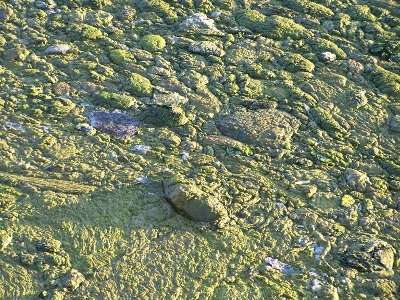- Gabby Fellows
- Posted On
Fellows: Cyanobacteria isn

Our lake, formally known as “Clear,” has recently gained “celebrity status” attention from Bay Area reporters inspecting our Cyanobacteria pandemic with their refined scope of discernment.
Local residents rant and rave when corporate media moguls exploit a good story at the cost of tarnishing Lake County’s public relation’s image.
Locals do not like headlines from news stations miles and miles away such as “toxic algae blooms” displayed across their computer or television screens.
When a corporate branded reporter hunts down and seeks out a good lead, they don’t usually consider the issue’s ramifications on the general populous.
They see the story as a great gem they found covered in mud.
Once taken back to the “studio” and polished, it’ll be turned into a diamond that’ll impress their bosses and shareholders and allow them to make their next BMW payment.
Don’t bother complaining about the “out-of-county” reporter’s spin on this local story.
If you have to waste the effort and place blame somewhere, try blaming the people interviewed by these vultures who were the ones that tipped them off to the story in the first place.
Those big city suits preyed on us and used our information, spitting us back out with a smug look on their face, knowing our simple minds wouldn’t realize the mess our need for attention had created until it was too late.
First reported on by the Press Democrat on Aug. 9 as a “Stinky mess along Clear Lake’s south shore,” CBS 5 in San Francisco ran with the story and turned it into a typical corporate media news package on Aug. 12, varnished on the surface by a catchy buzz word such as “toxic” to entice and sell the reader.
What else could we expect from a news outlet controlled indirectly by one of the six corporations that owns the rest of the electronic mediums we flock to in order to find our “news”?
Their motive for writing stories is the same as their bottom line: Profit.
The only people their bosses care about and need to impress are the shareholders.
KPIX is a CBS affiliate owned by Westinghouse Inc.
CBS is a publicly traded stock on the NYSE that is currently being traded at $10.55 a share. Their first quarter profit for 2009 was $3.2 billion.
Jeffrey Schaub, CBS 5 Greenbeat reporter, referred to all Lake County residents at the end of his piece as “those people” when attempting to correct his assessment of the situation.
The other clown-faced anchors merely bobbed their heads and said “those poor resort owners.”
Indeed, we should all be upset and feel sympathy for the lake shore business community, especially on the south end of the lake, that have been affected negatively from this ancient environment condition.
But what about the rest of the population that resides in this county of lake that doesn’t own a business? Doesn’t this issue affect them as well?

Is the drinking water safe?
The water supply seems to be the most important natural resource that could possibility be impacted by this problem.
Aside from the obvious negative impact to the tourism industry, this problem is making the environment unpleasant to live in for local residents and the water unfit for swimming and other lake related recreational activities.
In a press release published back in June, our government representatives declared the water unsafe to drink. County Health Officer Dr. Karen Tait advised people to stay away from areas with visible algae mats and not drink the water.
However, there was a distinction made between raw water and treated water running out of the pipes.
On face value, the general population that drinks and bathes with this water on a regular basis is supposed to trust our water companies and believe that they are doing the best they can in adhering to state standards.
One would think these companies would want to reassure their customers that their product is safe and healthy for human consumption.
There are three water companies that do business in the Clearlake community: Highlands Water Co., Konocti County Water Co. and Golden State.
None of them wished to speak about the quality of product they were selling to our local constituency.
However one of them, Golden State Water Co., actually scheduled an open house for Tuesday, Aug. 25, to discuss their general operations and “water quality” after being probed on the issue.
What we do know is very little about the treatment process our drinking water undergoes before reaching our lips.
Inside sources at Highlands Water Co., who requested anonymity, attempted to explain the treatment process for the raw water that is pumped out of Clearlake for treatment at their plant.
This source explained that when the pipeline transports the water from Beakbane Island to the Highlands treatment facility, the turbidity level is 11.68 percent.
After being treated, our drinking water’s turbidity level is reduced to 0.07 percent, which is significantly lower than the state’s 0.3 percent standard.
Turbidity merely refers to the clarity and clearness of the water before and after treatment.
There are several steps involved in the entire treatment process such as filtration through clarifiers with ozone, carbon filters and a final chlorine dose.
Potassium permanganate is also added during the process to aid in treating the algal cells present in the raw water.
This inorganic chemical compound can be purchased at pool supply stores and has historically been used to disinfect drinking water and to remove that “rotten egg” smell from well and wastewater.
Since the other two companies declined comment, we can merely assume that the entire treatment process all our drinking water undergoes is affectively “disinfecting” and killing all algal cells in our drinking water.
Although temporary solutions have already been enacted, such as breaking up the mats with various machinery, the county’s Web site details the most important long-term solution that needs to be addressed:
“Working in cooperation with the State Department of Water Resources and the University of California, Lake County officials completed studies that have shown there is an over-abundance of nutrients (food for the algae) within the lake. Because the lake is so large, spraying algae to reduce nuisance conditions is not a practical long-term solution. Reduction of lake nutrient levels is anticipated to reduce the quantities of nuisance, blue-green algae.”
The county recognizes that excessive nutrient levels in the lake are the main contributing factor causing the excessive algal blooms this season and are "anticipating" that in the future they might attempt to reduce nutrient levels.
How this feat will be carried out and what caused these excessive nutrient levels are questions left unanswered.
Two town hall meetings have already taken place down at Clearlake City Hall within the last two months. Economic and environmental concerns arising from the cyanobacteria problem were subjects of concern.
The next public forum addressing the issue will take place Monday, Aug. 31, at 6 p.m. at the Main Street Bar and Grill.
Joyce Overton, Dian Gibson and 15 residents will dine, discuss and conduct the first of hopefully a series of algae volunteer committee meetings aimed at creating an open dialogue about the problem, as well as encouraging possible long-term solutions.
An anonymous poster on this very site named “Ray” responded to an earlier commentary on the issue stating: “This is the greatest lake west of the Mississippi. Like a wife she’s not consistent, but you have to support her.”
Indeed, we must support our lake and her natural beauty for it makes all of us look good to the outside world.
Instead of blaming the out-of-county press for making us look bad, we should concentrate our efforts on fixing the problem and giving our tourists something to brag about.
Gabby Fellows is a freelance journalist from Humboldt County. She can be reached by e-mail at This email address is being protected from spambots. You need JavaScript enabled to view it..







